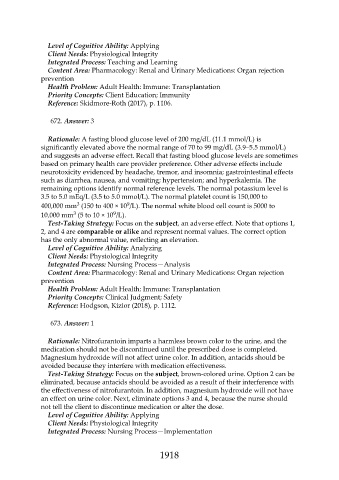Page 1918 - Saunders Comprehensive Review For NCLEX-RN
P. 1918
Level of Cognitive Ability: Applying
Client Needs: Physiological Integrity
Integrated Process: Teaching and Learning
Content Area: Pharmacology: Renal and Urinary Medications: Organ rejection
prevention
Health Problem: Adult Health: Immune: Transplantation
Priority Concepts: Client Education; Immunity
Reference: Skidmore-Roth (2017), p. 1106.
672. Answer: 3
Rationale: A fasting blood glucose level of 200 mg/dL (11.1 mmol/L) is
significantly elevated above the normal range of 70 to 99 mg/dL (3.9–5.5 mmol/L)
and suggests an adverse effect. Recall that fasting blood glucose levels are sometimes
based on primary health care provider preference. Other adverse effects include
neurotoxicity evidenced by headache, tremor, and insomnia; gastrointestinal effects
such as diarrhea, nausea, and vomiting; hypertension; and hyperkalemia. The
remaining options identify normal reference levels. The normal potassium level is
3.5 to 5.0 mEq/L (3.5 to 5.0 mmol/L). The normal platelet count is 150,000 to
9
3
400,000 mm (150 to 400 × 10 /L). The normal white blood cell count is 5000 to
3
9
10,000 mm (5 to 10 × 10 /L).
Test-Taking Strategy: Focus on the subject, an adverse effect. Note that options 1,
2, and 4 are comparable or alike and represent normal values. The correct option
has the only abnormal value, reflecting an elevation.
Level of Cognitive Ability: Analyzing
Client Needs: Physiological Integrity
Integrated Process: Nursing Process—Analysis
Content Area: Pharmacology: Renal and Urinary Medications: Organ rejection
prevention
Health Problem: Adult Health: Immune: Transplantation
Priority Concepts: Clinical Judgment; Safety
Reference: Hodgson, Kizior (2018), p. 1112.
673. Answer: 1
Rationale: Nitrofurantoin imparts a harmless brown color to the urine, and the
medication should not be discontinued until the prescribed dose is completed.
Magnesium hydroxide will not affect urine color. In addition, antacids should be
avoided because they interfere with medication effectiveness.
Test-Taking Strategy: Focus on the subject, brown-colored urine. Option 2 can be
eliminated, because antacids should be avoided as a result of their interference with
the effectiveness of nitrofurantoin. In addition, magnesium hydroxide will not have
an effect on urine color. Next, eliminate options 3 and 4, because the nurse should
not tell the client to discontinue medication or alter the dose.
Level of Cognitive Ability: Applying
Client Needs: Physiological Integrity
Integrated Process: Nursing Process—Implementation
1918

